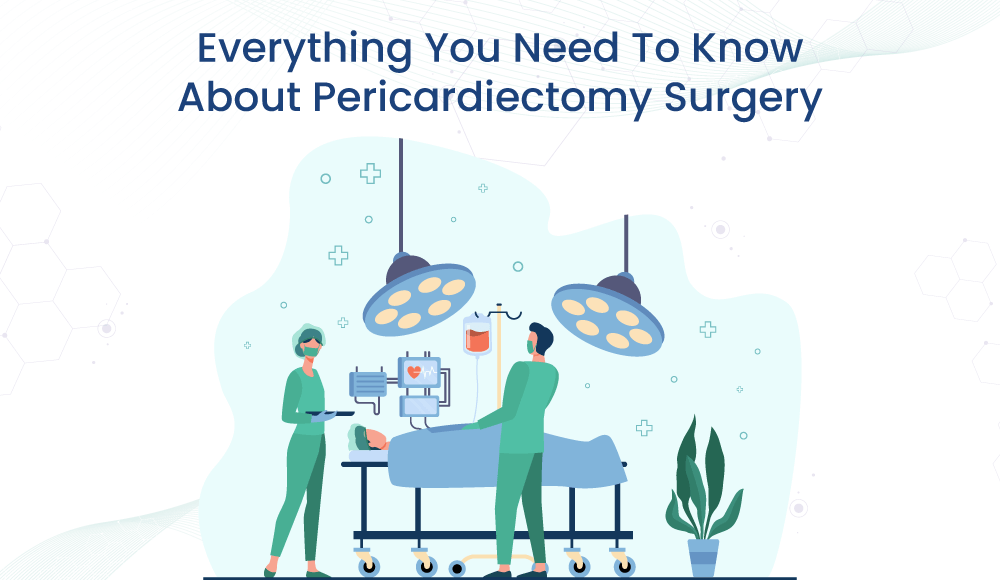Pericardiectomy surgery, also referred to as pericardial stripping surgery, is an open-heart surgery procedure performed to remove a section or all of the pericardium sac. When the pericardium, the protective sac around the heart, becomes rigid, it loses its ability to stretch properly, leading to symptoms of heart failure.
The surgery is most commonly done for patients with constrictive pericarditis, recurrent pericarditis, anti-inflammatory drug side effects, and rarely for cardiac tamponade. Patients thinking about or undergoing pericardiectomy surgery in India can have a detailed understanding of the procedure in this post, its recovery phase and make informed decisions.
Get personalized pericardiectomy aftercare guidance – Schedule your consultation now!
A] Understanding The Pericardium
The pericardium is a sac filled with fluid that surrounds the heart, providing a protective barrier and facilitating the optimal functioning of the heart. The pericardium covers the heart and the roots of the major blood vessels, commonly referred to as the “great vessels.” These great vessels comprise the aorta, main pulmonary artery, pulmonary veins, and superior and inferior vena cava.
Functions of pericardium:
- It acts as a cushion, protecting the heart from external pressure and forces.
- It also plays a role in holding the heart in its proper position.
- It also helps prevent the heart from expanding excessively and filling with excessive amounts of blood.
- It helps in protecting the heart from infections.
- It provides lubrication, reducing friction between the heart and the surrounding tissues, giving smooth heart movement.
B] Conditions Requiring Pericardiectomy
1. Constrictive pericarditis
Constrictive pericarditis is a medical condition where the pericardium becomes thicker and stiffer, resulting in heart failure. Some causes involve previous heart surgery, radiation to the chest, diseases like mesothelioma and tuberculosis, bacterial or viral infection, or an unknown cause termed “Idiopathic.”
Symptoms include fatigue, chest pain, dizziness, swelling in the lower legs and abdomen, and shortness of breath. Its impact on heart function is to restrict blood filling properly and increase pressure on the heart.
A pericardiectomy is the surgical treatment option to remove the pericardium. This surgery helps the heart beat more freely, relieving pressure. If you suffer from constrictive pericarditis, you can opt for pericardial stripping surgery in Mumbai to effectively treat these symptoms.
2. Chronic effusive pericardial disease
Chronic effusive pericardial disease refers to the prolonged inflammation of the pericardium, develops slowly over time and can lead to the thickening of the pericardium or fluid accumulation in the pericardial space. Some causes include cancer, underactive thyroid gland or hypothyroidism, tuberculosis, and chronic kidney disease.
Symptoms include shortness of breath, fatigue, coughing, fluid accumulation in the legs and abdomen, and sometimes in the lungs. When there is rapid fluid accumulation or insufficient stretching for the pericardium, it can cause severe pressure on the heart.
If you are thinking, ‘Why I might need a pericardiectomy’ in chronic pericarditis, you must be aware that this condition is brought on by inflammation which leads to fluid accumulation.
This can make it challenging for the heart to function normally. This is where pericardiectomy comes in as a solution for draining the fluid and preventing it from recurring.
C] Preparing For Pericardiectomy Surgery
Proper preparation and following the instructions before undergoing the pericarditis surgery is crucial to ensure a successful outcome of the surgery.
- Some evaluations and tests are conducted to know the patient’s current medical condition and overall health.
- Following preoperative evaluations, tests, consultations, and procedures is necessary while preparing for the pericardiectomy surgery. This includes reviewing patients’ medical history and conducting routine blood and urine tests to evaluate their overall health status.
- Diagnostics tests such as echocardiography, cardiac MRI, CT scan, and cardiac catheterization are conducted to evaluate heart function. Accurate diagnosis is necessary for identifying the particular disease, which helps guide the surgical approach.
- Patients preparing for pericardial stripping surgery in India are advised to change some of their lifestyles before the surgery, such as stop smoking for better healing and recovery. If there is any intake of medications like aspirin, it needs to be stopped before the surgery.
- Prior to pericardiectomy surgery in Mumbai, patients are instructed to have a regular bath and wear a surgical gown.
- The area where the operation will take place might require shaving and cleaning. Further, medications are provided for relaxation before the procedure.
D] The Pericardiectomy Procedure
Understanding the pericardiectomy procedure and the steps can help you make informed decisions, feel more confident about the treatment, and actively participate in your own healthcare journey. Additionally, it allows you to ask relevant questions, discuss potential risks and benefits with your healthcare provider, and have realistic expectations about the recovery process.
The pericardiectomy surgery involves the following step-by-step process:
Step 1: Before the surgery begins, an anaesthesiologist will inject you with general anaesthesia, ensuring that you sleep deeply and painlessly throughout the pericardiectomy procedure. The surgery might take several hours.
Step 2: In this step, the surgeon will use either the open heart surgical technique (sternotomy) or minimally invasive approaches (video-assisted thoracoscopic surgery). In sternotomy, the surgeon will make an incision vertically along the breastbone. Video-assisted thoracoscopic surgery, or VATS, is used where several small incisions are made on the side of the chest.
Step 3: The surgeon will make the incision long enough to separate the breastbone or reach the pericardium to access the heart.
Step 4: The surgeon will now remove the entire pericardium or a large portion.
Step 5: After removing the pericardium, the surgeon will repair the necessary issues on the heart.
Step 6: After the pericardium removal and necessary repairs, the skin and muscle incisions are closed, and bandages are applied to the incision site.
Surgeons also use other surgical techniques such as partial pericardiectomy, i.e., removal of only a portion of the pericardium or complete pericardiectomy, i.e., completely separating the pericardium.
Risks and Complications
Potential risks and complications of pericardiectomy surgery include bleeding, infection, blood clot, abnormal heart rhythms, pneumonia, heart attack and fluid accumulation. These risks can be mitigated and managed by careful surgical technique and proper care. Open communication with healthcare providers helps identify these risks quickly and start the treatment.
E] Recovery and Post-operative Care
- After the surgery, it is advised to stay in the hospital for five to seven days, where patients will receive effective monitoring from the treating surgeon.
- For pain management and infection prevention, patients must take precautions as the surgeon advises.
- Post-operative care involves follow-up appointments and long-term monitoring with a Cardiac surgeon to recover fully.
- Full recovery usually takes about six to eight weeks, although the duration may vary based on the severity of the condition before surgery.
- Patients can return to normal activities but are advised not to lift heavy objects.
Get personalized pericardiectomy aftercare guidance – Schedule your consultation now!
Conclusion
Pericardiotomy is a open-heart surgical procedure to treat conditions such as constrictive pericarditis, recurrent pericarditis, anti-inflammatory drug side effects, and rarely for cardiac tamponade by removing a portion or the entire pericardium surrounding the heart. If would like to know about open heart surgery cost in Mumbai, you can refer to our blog.
If you or someone you know needs to undergo a pericardiectomy, you should contact a reputed pericardiectomy surgeon in India to schedule a consultation who can not only provide you with accurate diagnosis but also offer better surgical outcomes.




